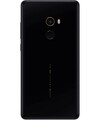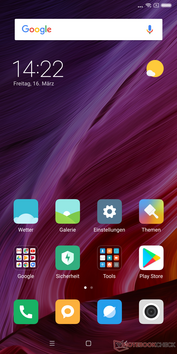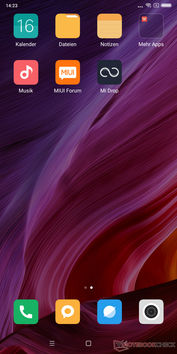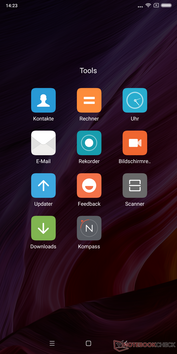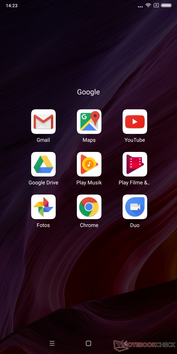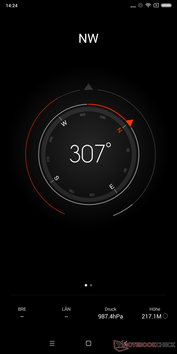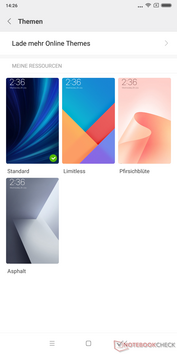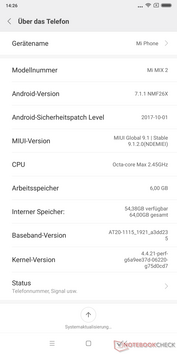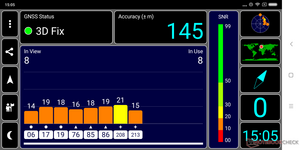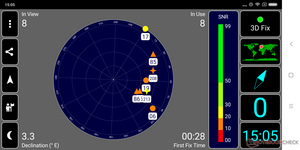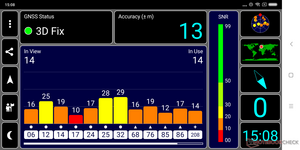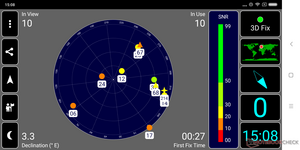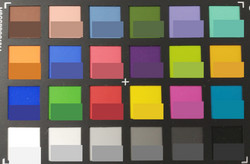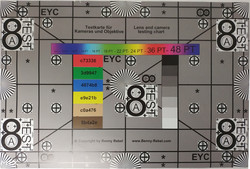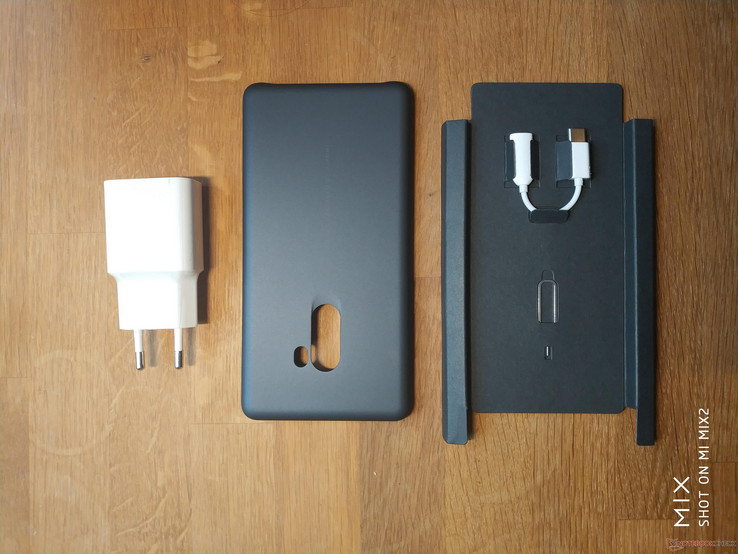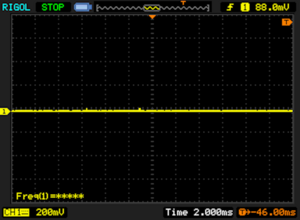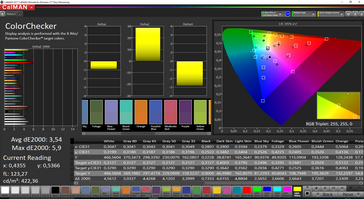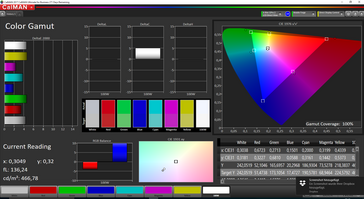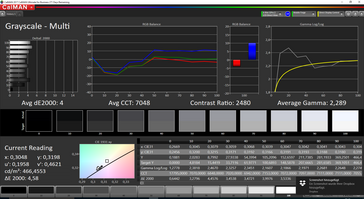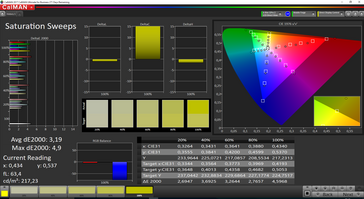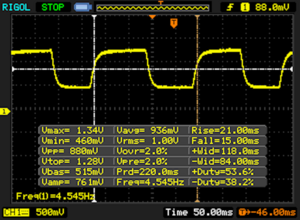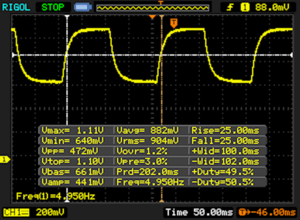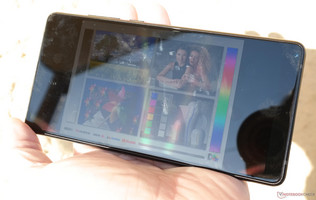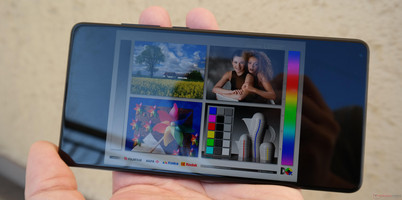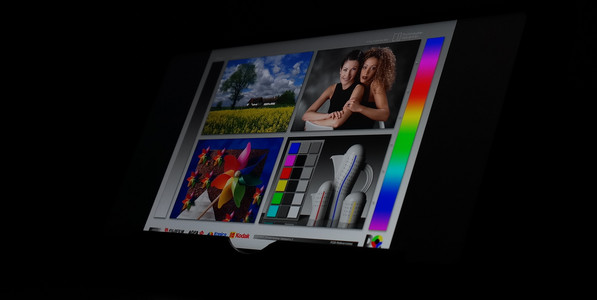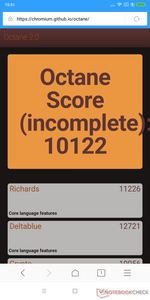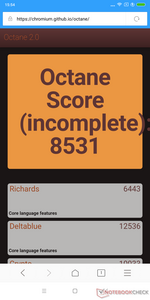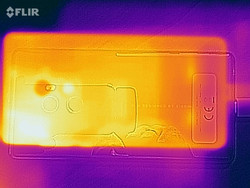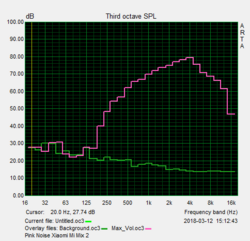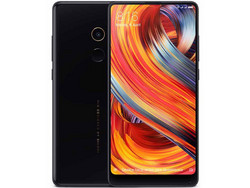Xiaomi Mi Mix 2 Smartphone Review

The Xiaomi Mi Mix 2 is made to impress. The moment you open its box, you are met with the sight on an enormous screen, an elegantly designed case and a beautiful user interface named MIUI. The device is equipped with a Qualcomm Snapdragon 835 processor and an Adreno 540 GPU, 6 GB of RAM and storage options ranging from 64 to 256 GB. The whole package is completed by numerous sensors and Sony cameras. The aim of this review, however, is not to be blinded by the device's impressive technical specifications and gorgeous looks, but to put the smartphone through its paces and see how it compares to its competitors.
While Xiaomi is achieving good sales figures with its products in its home market, China, the only country in which the phones are officially distributed outside of China is Spain. However, you can still purchase the devices from importers. Our test unit is currently available for $500 on Amazon.
As this is a high-end device, we have chosen other flagship models such as the predecessor, Xiaomi Mi Mix, the Samsung Galaxy S8 and the OnePlus 5T as comparison devices. People who are still wavering on their preferred OS might also be interested in a comparison with the Apple iPhone X.
Case - stable and elegant
Compared to its predecessor, the Mix 2 has shrunk from 6.4 inches to 6 inches. The screen resolution has increased slightly; however, and the aspect ratio has changed to 18:9 or 2:1. The frame and back of the device are still made of gray-black ceramic. The reflective material on the back feels like glass thanks to its smooth surface, but is a lot more protective against cuts and scratches than the touchscreen is.
Due to the nicely flowing transitions, the flush camera and the smooth material, the Mi Mix 2 looks as if it was made from one piece. One disadvantage of the smooth surface is that it shows up fingerprints very quickly, and tends to be slippery on slanted surfaces or when held in damp hands. The device comes with an additional protective cover, which is very helpful here. It also prevents damage to the device to a certain extent, but we would still recommend being particularly careful due to the bezel-free construction and ceramic frame.
As well as reducing the size from 158.8 x 81.9 x 7.9 mm (~ 6.2 x 3.2 x 0.31 in) to 151.8 x 75.5 x 7.7 mm (~ 5.9 x 2.9 x 0.3 in), the weight has also dropped to 185 grams (~ 6.5 oz). Apart from its predecessor, the Mi Mix 2 is still the heaviest device of our comparison field. This becomes more relative when you look at the weight and dimensions of the iPhone X. Only the Samsung Galaxy S8 has impressive dimensions, but it also has a slightly lighter glass back. Subjectively, the relatively high weight gives a good impression and underlines its high quality. Another proof of quality is the high warp resistance of the case.
Connectivity - a USB-C and Dual-SIM smartphone
Inside, the Xiaomi comes with a high-end processor from Qualcomm, the Snapdragon 835, and an Adreno 540 GPU. Together with 6 GB of RAM and storage options ranging from sufficient to lavish (64 to 256 GB available), the smartphone looks promising on paper. Following the current fashion of high-end smartphones, the battery cannot be exchanged. The device is a dual-SIM model and therefore has two Nano-SIM trays.
The device overhaul has meant that the classic 3.5-inch headset jack had to be removed. However, the device is delivered with an adapter for the remaining USB Type-C port. Unfortunately, the latter still only supports USB 2.0 speeds, which means that data can be transmitted at a maximum rate of 35 MB/s. We were pleased with the fact that USB-OTG is supported in order to connect peripheral devices. Although the storage of the Mi Mix 2 cannot be expanded via a microSD card, it should have sufficient space available, with configurations ranging from 64 to 256 GB. Apart from the two Nano-SIM slots, the device is also equipped with ac Wi-Fi including Wi-Fi Direct, Bluetooth 5 and NFC for wireless data transfers. The Wi-Fi module now seems to support MIMO technology, which we will talk about later on. There is a fingerprint reader on the back of the device that easily activates and unlocks the device. The placement has its advantages, but we have also seen very effective solutions for front sensors, for example on the Motorola Moto G5s Plus.
Software - Android smartphone with MIUI
The Xiaomi Mi Mix 2 is equipped with the Android 7.1.1 operating system with MIUI Global 9.1. Unlike its predecessor, the device is available in a "global" version, which includes all relevant Google apps. Chinese applications, which are of no use to non-Chinese-speaking users, are not installed in this version. Both the looks and functionality of the user interface differ from Stock Android. For example, the device does not have an app drawer and installed apps are accessible directly from the home screen, which we personally welcome as it improves usability. Similar to the Mi Mix, the system is highly customizable: Some useful additional features are "child mode", which only allows access to certain, previously defined apps, as well as the "dual apps" function, which allows you to install apps twice and use them independently. The Quick Ball is still included, but it has to be activated in the settings. The device also offers an optional one hand mode to make using the phone with only one hand easier.
Communication and GPS - fast Wi-Fi, weak GPS
The updated Mi Mix 2 has become even more communicative. The device now supports the LTE band 20 and offers Bluetooth 5.0, as well as improved Wi-Fi connections. Compared to its predecessor, the mobile network speeds have doubled thanks to MIMO 2x2 technology. Our test unit reached 656 Mbit/s when receiving data with our reference router Linksys EA8500 compared to 289 Mbit/s with the Mi Mix, and managed transmit speeds of up to 585 Mbit/s. This means that the Xiaomi smartphone has caught up with the frontrunners and only the iPhone X can beat it at receiving data. When transmitting, the iPhone falls behind a little and the Mix 2 takes third place after the Samsung Galaxy S8 and the OnePlus 5T.
| Networking | |
| iperf3 transmit AX12 | |
| Samsung Galaxy S8 | |
| OnePlus 5T | |
| Xiaomi Mi Mix 2 | |
| Apple iPhone X | |
| Xiaomi Mi Mix | |
| iperf3 receive AX12 | |
| Apple iPhone X | |
| Xiaomi Mi Mix 2 | |
| OnePlus 5T | |
| Samsung Galaxy S8 | |
| Xiaomi Mi Mix | |
The GPS results were a little quirky, particularly when using the app "GPS test". Indoors, the device positioned us relatively quickly, but the result was within 100 meters (~109 yd), which is quite inaccurate. The second test was more realistic. This is a little surprising as the device performed well during our bicycle ride. The deviation compared to our reference navigator Garmin Edge 500 was not too high. Over a total route of 6.5 km (~4 mi), the difference was about 50 meters (~55 yd). These are great results. The difference can be explained by the smaller frequency of connections, which we encounter in almost all smartphones. You can see this from the more "angular" route images below.
The Mi Mix 2 uses GPS satellites, as well as the Russian GLONASS and Chinese BeiDou networks for positioning.
Call and Voice Quality - Clear and noise-free
Xiaomi's telephone app has a number block, a call log and a search option on its start screen. A second tab within the app shows all stored contacts. We were not able to find a possibility to include contacts stored on the SIM card. It seems as if this option has been removed. As the Mi Mix 2 is almost bezel-less at the top, it cannot be equipped with a standard earpiece. Instead, it uses a piezoceramic element which is placed behind the display. The loud, noise-free, but slightly muffled sound can easily keep up with most traditional smartphones, with only a few cutbacks for natural sound. Background noises are suppressed efficiently. Our call partner always heard us clearly and there were no glitches. The microphones also work well on speakerphone, and the strong speaker ensured that we always heard our call partner clearly.
Cameras - not much left to be desired
The front camera of the Mi Mix has a resolution of 5 megapixels. It is not positioned at the top of the display, but in the bottom right corner. Xiaomi recommends turning the phablet by 180 degrees when taking a selfie, so as not to cover the lens by mistake, which happened during our test and is particularly likely for right-handed users. It takes quite nice, detailed photos in daylight, but the image sharpness drops noticeably indoors, particularly when the subject is very close. Videos can be made in Full HD resolution and offer decent quality.
The main camera has a 12-MP sensor from Sony - the IMX 386 Exmor. (No, it was not taken out of an old IBM-compatible PC.) The image quality outdoors looks great. The photos show high details, but are not too sharp. We occasionally missed an optical image stabilizer indoors, as photos tend to blur otherwise. The short shutter lag is good. The Mi Mix 2 can record videos at UHD resolution with autofocus or manual focus (by tapping the screen). You can also record slow-motion videos with a resolution of 1280x720 pixels and 120 images per second. Their quality is only good enough for small screens, however.
The camera app offers various modes such as "beautify", "panorama" or "tilt shift", but also a manual mode in which you can adjust the white balance, exposure, focus point and ISO sensitivity. In general, the photo app is quite intuitive and easy to use, but can still be configured in detail in the settings. Hardware keys can be used as shutter release or to set brightness, and the lag for time lapse videos can be adjusted as well.
In order to test the color accuracy of the Xiaomi Mi Mix 2's main camera, we have compared photos taken under controlled lighting conditions to the X-Rite ColorChecker passport, which shows the real reference colors. We did not process the image, for example by manually adjusting the white balance. You can see that most colors look stronger than they are in reality. While the intensity is not accurate, the actual color tones look quite good. We test the image performance of the lens and sensor resolution by taking a picture of our test chart in controlled artificial light. This shows slightly reduced resolution at the edges, but nothing to be worried about. Single color surfaces appear irregular close-up and you can see yellowish color fringes along hard contrasts. However, these are hardly noticeable in reality. Subjectively, the images gave us a good impression.
Accessories and Warranty - an imported phone
Apart from the power supply and USB-C cable, the test unit is only equipped with a slightly metallic plastic cover that protects the back and frame from damage. We know from experience that plastic tends to break sooner or later. The scope of delivery does not include headphones, but instead it offers a USB-C-to-audio adapter to replace the missing audio jack. However, it is not very comfortable having to carry that around. Another alternative would be to use Bluetooth headphones. The device is now available on Amazon and also has CE labelling, which its predecessor did not. Therefore, it does not really make sense to import the device directly from China, particularly as there is no big difference in price. When purchasing the unlocked phone from a retailer, you will benefit from legal warranty and an uncomplicated return policy if you are not happy with the device. This should justify the slightly higher price.
Please see our Guarantees, Return Policies and Warranties FAQ for country-specific information.
Input Devices & Handling - fast sensors and responsive touchscreen
The touchscreen of the test unit is very responsive even at the edges - despite its unusual almost bezel-free build. Fingers glide over the glass surface nicely. We measured the response time of the 10-point touchscreen by playing Chopsticks on Gismart's "Real Piano" app. Subjectively, all keys reacted quickly and without noticeable lag. The installed keyboard, GBoard, is useful for inputs in several languages.
The fingerprint reader on the back of the Mi Mix 2 is positioned well, as long as the phablet is held in one hand. It responds reliably and quickly. If you want to activate the display without picking up the phone, you can also double-tap the screen. The volume rocker and power button have a clear, but not too strong pressure point and sit snugly in their slots. As we would have expected based on the excellent technical specifications, the operating system runs very smoothly and there are no lags when responding to user inputs.
Display - bright, sharp, color-accurate
Compared to last year, the screen of the Mix 2 has improved slightly. The number of pixels has increased to 2160x1080, and as the device itself has shrunk, pixel density has increased from 361 to 402 PPI. But these values hardly impact day-to-day use, as the difference is barely noticeable to the naked eye. The fact that the screen brightness has decreased by about 100 cd/m² to 472 cd/m² is more interesting. This is still a good value, but not quite as bright as the Xiaomi Mi Mix. The rounded edges of the panel are unusual, but this makes them fit even more seamlessly into the case design. The predecessor and the Maze Alpha X already had similar features, although the latter's implementation of it was a lot sloppier.
| |||||||||||||||||||||||||
Brightness Distribution: 87 %
Center on Battery: 472 cd/m²
Contrast: 1748:1 (Black: 0.27 cd/m²)
ΔE ColorChecker Calman: 3.5 | ∀{0.5-29.43 Ø4.77}
ΔE Greyscale Calman: 4 | ∀{0.09-98 Ø5}
100% sRGB (Calman 2D)
Gamma: 2.29
CCT: 7048 K
| Xiaomi Mi Mix 2 IPS, 2160x1080, 6" | Xiaomi Mi Mix IPS, 2040x1080, 6.4" | Samsung Galaxy S8 Super AMOLED, 2960x1440, 5.8" | OnePlus 5T AMOLED, 2160x1080, 6" | Apple iPhone X Super AMOLED, 2436x1125, 5.8" | |
|---|---|---|---|---|---|
| Screen | -2% | 19% | 19% | 42% | |
| Brightness middle (cd/m²) | 472 | 577 22% | 566 20% | 425 -10% | 600 27% |
| Brightness (cd/m²) | 430 | 576 34% | 564 31% | 423 -2% | 606 41% |
| Brightness Distribution (%) | 87 | 89 2% | 94 8% | 92 6% | 94 8% |
| Black Level * (cd/m²) | 0.27 | 0.42 -56% | |||
| Contrast (:1) | 1748 | 1374 -21% | |||
| Colorchecker dE 2000 * | 3.5 | 2.7 23% | 2.7 23% | 2.1 40% | 1.2 66% |
| Colorchecker dE 2000 max. * | 5.9 | 6.9 -17% | 5.4 8% | 3.4 42% | 3 49% |
| Greyscale dE 2000 * | 4 | 4.2 -5% | 3.1 22% | 2.5 37% | 1.6 60% |
| Gamma | 2.29 96% | 2.23 99% | 2.15 102% | 2.32 95% | 2.23 99% |
| CCT | 7048 92% | 7287 89% | 6335 103% | 6455 101% | 6707 97% |
| Color Space (Percent of AdobeRGB 1998) (%) | 81.57 | ||||
| Color Space (Percent of sRGB) (%) | 99.87 |
* ... smaller is better
Screen Flickering / PWM (Pulse-Width Modulation)
| Screen flickering / PWM not detected | |||
In comparison: 53 % of all tested devices do not use PWM to dim the display. If PWM was detected, an average of 8084 (minimum: 5 - maximum: 343500) Hz was measured. | |||
The black value and contrast are good in this panel. The Xiaomi Mix 2 can beat its competition and actually has the highest contrast ratio. Color accuracy is a little below the level of its predecessor and our test unit made last place in our comparison field with a DeltaE value of 3.5. But this is still a very good value. And do not forget that the iPhone, for example, costs about twice as much.
Display Response Times
| ↔ Response Time Black to White | ||
|---|---|---|
| 36 ms ... rise ↗ and fall ↘ combined | ↗ 21 ms rise | |
| ↘ 15 ms fall | ||
| The screen shows slow response rates in our tests and will be unsatisfactory for gamers. In comparison, all tested devices range from 0.1 (minimum) to 240 (maximum) ms. » 93 % of all devices are better. This means that the measured response time is worse than the average of all tested devices (20.2 ms). | ||
| ↔ Response Time 50% Grey to 80% Grey | ||
| 50 ms ... rise ↗ and fall ↘ combined | ↗ 25 ms rise | |
| ↘ 25 ms fall | ||
| The screen shows slow response rates in our tests and will be unsatisfactory for gamers. In comparison, all tested devices range from 0.165 (minimum) to 636 (maximum) ms. » 85 % of all devices are better. This means that the measured response time is worse than the average of all tested devices (31.6 ms). | ||
Performance without end
The Mi Mix 2 is equipped with Qualcomm's current top processor, the Snapdragon 835. It has eight cores of the Kryo series, four of which clock at up to 1.9 GHz, while the others reach up to 2.46 GHz. The graphics are taken care of by an Adreno 540 GPU, which also has large power reserves that, despite the high display resolution, are pushed to the limit only by a few current games. As the chosen comparison devices all belong to the high-end segment, it is a neck-and-neck race in most areas - particularly if you leave out the iPhone X, which often claims pole position.
| AnTuTu v6 - Total Score (sort by value) | |
| Xiaomi Mi Mix | |
| Samsung Galaxy S8 | |
| OnePlus 5T | |
| Apple iPhone X | |
| Average Qualcomm Snapdragon 835 (8998) (150208 - 185487, n=17) | |
| PCMark for Android | |
| Work performance score (sort by value) | |
| Xiaomi Mi Mix 2 | |
| Xiaomi Mi Mix | |
| Samsung Galaxy S8 | |
| OnePlus 5T | |
| Average Qualcomm Snapdragon 835 (8998) (6854 - 9927, n=20) | |
| Work 2.0 performance score (sort by value) | |
| Xiaomi Mi Mix 2 | |
| Samsung Galaxy S8 | |
| OnePlus 5T | |
| Average Qualcomm Snapdragon 835 (8998) (5603 - 7510, n=20) | |
| GFXBench 3.1 | |
| on screen Manhattan ES 3.1 Onscreen (sort by value) | |
| Xiaomi Mi Mix 2 | |
| Xiaomi Mi Mix | |
| Samsung Galaxy S8 | |
| OnePlus 5T | |
| Apple iPhone X | |
| Average Qualcomm Snapdragon 835 (8998) (15 - 59, n=19) | |
| Average of class Smartphone (11 - 166, n=156, last 2 years) | |
| 1920x1080 Manhattan ES 3.1 Offscreen (sort by value) | |
| Xiaomi Mi Mix 2 | |
| Xiaomi Mi Mix | |
| Samsung Galaxy S8 | |
| OnePlus 5T | |
| Apple iPhone X | |
| Average Qualcomm Snapdragon 835 (8998) (21 - 43, n=19) | |
| Average of class Smartphone (8.4 - 413, n=155, last 2 years) | |
| Lightmark - 1920x1080 1080p (sort by value) | |
| Samsung Galaxy S8 | |
| Average Qualcomm Snapdragon 835 (8998) (32.1 - 38.7, n=5) | |
| Basemark X 1.1 | |
| Medium Quality (sort by value) | |
| Samsung Galaxy S8 | |
| Average Qualcomm Snapdragon 835 (8998) (n=1) | |
| High Quality (sort by value) | |
| Samsung Galaxy S8 | |
| Average Qualcomm Snapdragon 835 (8998) (38752 - 38773, n=2) | |
| Basemark ES 3.1 / Metal - offscreen Overall Score (sort by value) | |
| Samsung Galaxy S8 | |
| Apple iPhone X | |
| Average Qualcomm Snapdragon 835 (8998) (733 - 889, n=6) | |
| Average of class Smartphone (205 - 7731, n=34, last 2 years) | |
| Epic Citadel - Ultra High Quality (sort by value) | |
| Samsung Galaxy S8 | |
| Average Qualcomm Snapdragon 835 (8998) (60 - 60.1, n=2) | |
We had some difficulties evaluating the browser performance: Apart from Kraken and WebXPRT, none of the benchmarks were completed successfully. The Xiaomi phone achieved expected results in the Mozilla benchmark, but the WebXPRT showed surprisingly low values. We tried running Octane twice with significant differences in the results (between 10000 and 8000) and a note saying that not all tests could be carried out properly. JetStream gave us no results at all with the same explanation. The reason for these failed tests could be the Chrome browser, which is not quite up-to-date anymore at version 53. Subjectively, we noticed no difficulties and all tested sites loaded quickly and were displayed correctly.
| JetStream 1.1 - Total Score | |
| Apple iPhone X (IOS 11.1.1) | |
| OnePlus 5T (Chrome 63) | |
| Average Qualcomm Snapdragon 835 (8998) (52.9 - 80.4, n=19) | |
| Samsung Galaxy S8 (Samsung Browser 5.2) | |
| Xiaomi Mi Mix (Chrome 55) | |
| Octane V2 - Total Score | |
| Average of class Smartphone (2228 - 126661, n=195, last 2 years) | |
| Apple iPhone X (IOS 11.1.2) | |
| Samsung Galaxy S8 (Samsung Browser 5.2) | |
| OnePlus 5T (Chrome 63) | |
| Average Qualcomm Snapdragon 835 (8998) (3086 - 14300, n=20) | |
| Xiaomi Mi Mix 2 (Chrome 53) | |
| Xiaomi Mi Mix (Chrome 55) | |
| Mozilla Kraken 1.1 - Total | |
| Average Qualcomm Snapdragon 835 (8998) (2425 - 4813, n=19) | |
| OnePlus 5T (Chrome 63) | |
| Xiaomi Mi Mix 2 (Chrome 53) | |
| Xiaomi Mi Mix (Chrome 55) | |
| Samsung Galaxy S8 (Samsung Browser 5.2) | |
| Average of class Smartphone (257 - 28190, n=155, last 2 years) | |
| Apple iPhone X (IOS 11.1.2) | |
| WebXPRT 2015 - Overall | |
| Apple iPhone X (Safari Mobile 11.0) | |
| Samsung Galaxy S8 (Samsung Browser 5.2) | |
| OnePlus 5T (Chrome 63) | |
| Average Qualcomm Snapdragon 835 (8998) (57 - 204, n=17) | |
| Xiaomi Mi Mix (Chrome 55) | |
| Xiaomi Mi Mix 2 (Chrome 53) | |
* ... smaller is better
The Mi Mix 2 also managed great storage speeds and has improved by 23% compared to its predecessor.
| Xiaomi Mi Mix 2 | Xiaomi Mi Mix | Samsung Galaxy S8 | OnePlus 5T | Apple iPhone X | Average 64 GB eMMC Flash | Average of class Smartphone | |
|---|---|---|---|---|---|---|---|
| AndroBench 3-5 | -23% | -3% | 4% | -5% | 801% | ||
| Sequential Read 256KB (MB/s) | 704 | 409.9 -42% | 793 13% | 699 -1% | 277 ? -61% | 2245 ? 219% | |
| Sequential Write 256KB (MB/s) | 208.6 | 161.3 -23% | 193.2 -7% | 203.4 -2% | 178.4 ? -14% | 1877 ? 800% | |
| Random Read 4KB (MB/s) | 148.5 | 116.6 -21% | 127.2 -14% | 138.1 -7% | 60.7 ? -59% | 298 ? 101% | |
| Random Write 4KB (MB/s) | 15.75 | 15.15 -4% | 15.25 -3% | 20 27% | 33.8 ? 115% | 344 ? 2084% | |
| Sequential Read 256KB SDCard (MB/s) | 63.9 ? | 77.4 ? | |||||
| Sequential Write 256KB SDCard (MB/s) | 53.5 ? | 58.3 ? |
Games - the Xiaomi is not a cheap phone and offers decent performance
Thanks to the fast Adreno 540 GPU, the Mi Mix 2 can even display graphically demanding games smoothly. You will have no issues playing "Beach Buggy Racing" at the highest quality settings on this device. The response of the gyroscope is easy to test in racing games. Again, the smartphone reacts precisely and without noticeable lags.
Emissions
Temperature - not suitable as a hand warmer
While idling, the Xiaomi Mi Mix 2 hardly heats up at the back, with average temperatures of about 30 °C (~86 °F). Only the front heats up a bit more to 33 °C (~91 °F) in the bottom area. Under constant load, our measurements reach a maximum of 37 °C (~99 °F). The device becomes lukewarm at most in some areas, but mostly remains below body temperature. If you are looking for a phone to warm your hands on cold days, this is not the one.
(+) The maximum temperature on the upper side is 34 °C / 93 F, compared to the average of 35.2 °C / 95 F, ranging from 21.9 to 247 °C for the class Smartphone.
(+) The bottom heats up to a maximum of 37.1 °C / 99 F, compared to the average of 34 °C / 93 F
(+) In idle usage, the average temperature for the upper side is 30.4 °C / 87 F, compared to the device average of 32.9 °C / 91 F.
Speakers - good average
At 86.6 dB(A), the single speaker, positioned on the side of the Xiaomi Mi Mix, reaches sufficient volume. The sound quality is decent for a smartphone, although the test unit cannot reach top positions in our comparison. As usual, bass frequencies are not very present, but depending on what is being played, the sound can even appear spatial and is free of strong distortions. If you connect headphones via the USB-C-to-3.5-mm connector, you will be rewarded with seemingly impeccable sound quality: No noise or other bothersome sounds can be heard.
Xiaomi Mi Mix 2 audio analysis
(+) | speakers can play relatively loud (86.6 dB)
Bass 100 - 315 Hz
(-) | nearly no bass - on average 29.5% lower than median
(±) | linearity of bass is average (11.2% delta to prev. frequency)
Mids 400 - 2000 Hz
(±) | higher mids - on average 5.1% higher than median
(+) | mids are linear (5.3% delta to prev. frequency)
Highs 2 - 16 kHz
(±) | higher highs - on average 7.4% higher than median
(+) | highs are linear (5.2% delta to prev. frequency)
Overall 100 - 16.000 Hz
(±) | linearity of overall sound is average (26% difference to median)
Compared to same class
» 65% of all tested devices in this class were better, 6% similar, 28% worse
» The best had a delta of 11%, average was 35%, worst was 134%
Compared to all devices tested
» 79% of all tested devices were better, 4% similar, 16% worse
» The best had a delta of 4%, average was 24%, worst was 134%
Apple iPhone X audio analysis
(+) | speakers can play relatively loud (85.3 dB)
Bass 100 - 315 Hz
(±) | reduced bass - on average 14.9% lower than median
(±) | linearity of bass is average (9.4% delta to prev. frequency)
Mids 400 - 2000 Hz
(+) | balanced mids - only 3.4% away from median
(+) | mids are linear (5.1% delta to prev. frequency)
Highs 2 - 16 kHz
(±) | higher highs - on average 7.3% higher than median
(+) | highs are linear (4.6% delta to prev. frequency)
Overall 100 - 16.000 Hz
(±) | linearity of overall sound is average (19% difference to median)
Compared to same class
» 24% of all tested devices in this class were better, 9% similar, 67% worse
» The best had a delta of 11%, average was 35%, worst was 134%
Compared to all devices tested
» 44% of all tested devices were better, 8% similar, 48% worse
» The best had a delta of 4%, average was 24%, worst was 134%
Frequency diagram in comparison (check boxes can be turned on/off!)
Battery Runtimes - on the same level as the competition
Power Consumption
The predecessor was not efficient, but the Mi Mix 2 now offers significant improvements: According to our calculations, power consumption has improved by 53% on average. The results are particularly good under load, where the rates have dropped considerably from 9.21 to 3.18, and are now on the same level as the comparison devices.
| Off / Standby | |
| Idle | |
| Load |
|
Key:
min: | |
| Xiaomi Mi Mix 2 3771 mAh | Xiaomi Mi Mix 4400 mAh | Samsung Galaxy S8 3000 mAh | OnePlus 5T 3300 mAh | Apple iPhone X 2716 mAh | |
|---|---|---|---|---|---|
| Power Consumption | -53% | 18% | 15% | -12% | |
| Idle Minimum * (Watt) | 0.69 | 0.87 -26% | 0.78 -13% | 0.58 16% | 1.03 -49% |
| Idle Average * (Watt) | 2.03 | 2.16 -6% | 1.1 46% | 1.44 29% | 2.4 -18% |
| Idle Maximum * (Watt) | 2.1 | 2.28 -9% | 1.16 45% | 1.53 27% | 2.6 -24% |
| Load Average * (Watt) | 3.18 | 9.21 -190% | 4.15 -31% | 3.17 -0% | 2.96 7% |
| Load Maximum * (Watt) | 8.73 | 11.76 -35% | 5.12 41% | 8.54 2% | 6.6 24% |
* ... smaller is better
Battery Runtime
The good consumption rates are reflected in the battery runtimes, which are a little below those of last year's model. However, the predecessor's battery was 30% larger. The iPhone X has the shortest runtimes of all competitors, but then it is also equipped with the smallest battery at 2716 mAh. The most energy-efficient device is probably the Samsung Galaxy S8, which wins almost all ratings while having the second-smallest battery.
We cannot complain about the charging time - a full recharge takes little over an hour with the included power supply.
| Xiaomi Mi Mix 2 3771 mAh | Xiaomi Mi Mix 4400 mAh | Samsung Galaxy S8 3000 mAh | OnePlus 5T 3300 mAh | Apple iPhone X 2716 mAh | |
|---|---|---|---|---|---|
| Battery runtime | 7% | 20% | 20% | -6% | |
| WiFi v1.3 (h) | 10 | 10.7 7% | 12 20% | 12 20% | 9.4 -6% |
| Reader / Idle (h) | 30 | 27.8 | 29.2 | 21.5 | |
| H.264 (h) | 16.1 | 12.9 | 13.3 | 10.6 | |
| Load (h) | 4.9 | 4.4 | 4.3 | 3 |
Pros
Cons
Verdict - an alternative to established brands
Our verdict of the Xiaomi Mi Mix 2 is easy to make: It offers high quality, an attractive design and a robust case. The display leaves nothing to be desired and handling is easy and enjoyable. The camera is not the best, but can still be placed towards the top of the scale.
In short: The Mi Mix 2 does not have any big deficiencies. In addition, the smartphone can now be purchased through retailers, which takes away some of the uncertainty around buying an imported phone.
After our short test, we can answer the question "Should I buy the Xiaomi Mi Mix 2?" with a resounding "Yes". But our verdict does not end here. The difficult question is: Why should you buy the Xiaomi and not a Samsung Galaxy S8, a OnePlus 5T, or even an iPhone X?
A Chinese smartphone with an excellent design and great interface that has no weaknesses. The device is comparable with established brands such as Samsung - but so is its price.
While the iPhone comparison can be settled quite quickly by looking at its price (double) and your OS preferences, the other candidates are not so easily put to the side. Not only do they offer the same operating system, but there is also hardly any difference in price. A Galaxy S8 can be purchased for $600 on Amazon; the OnePlus 5T is available for $560. The Xiaomi Mi Mix 2 costs $500, which, granted, is $100 cheaper, but still within striking distance. China does not just produce cheap mobile phones anymore.
The decision will have to be made based on the small details. The Galaxy S8, for example, is water-resistant, while the OnePlus 5T and the Mi Mix 2 both offer dual-SIM slots.
In the end, it is a matter of taste. But whatever you decide, you will receive a good, up-to-date smartphone.
Xiaomi Mi Mix 2
- 03/23/2018 v6 (old)
Florian Schaar






